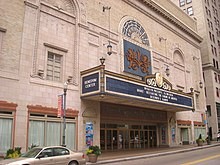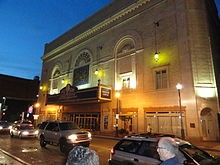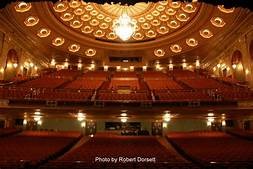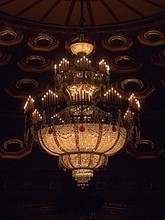Benedum Center for Performing Arts (Stanley Theater and Clark Building), Pittsburgh
Introduction
Text-to-speech Audio
Images
Benedum Theater (Daytime)

Benedum Theater (Nighttime)

Stanley Theater Sign: An Artifact of the Theater's Origins
%2C_Pittsburgh%2C_2019-10-15%2C_02.jpg)
Inside of the Benedum Theater

One of the 90 Chandeliers in the Benedum Center

Stanley Theater Artwork

Backstory and Context
Text-to-speech Audio
Between 1926-1927, James Bly Clark, the vice-president of the Stanley-Clark Motion Picture Company and the founder of the Pittsburgh branch of the firm, financed three million dollars toward the the construction project of the Stanley Theater and Clark Building. Clark contracted Hoffman-Henon, the nation's most predominant architecture firm during the twentieth-century that specialized in constructing movie theaters. In 1928, the construction for both the Stanley Theater and Clark Building were completed and opened for business. The Stanley Theater was operated by both Metro-Goldwyn Mayer and Stanley Warner Theater, a circuit division of Warner Bros. Theaters. The theater was the first Pittsburgh theater to release Warner Bros. films. The Stanley Theater and Clark Building were proven as a revolutionary design because it was one of the first theaters to utilize a more "modernistic" or Art-Deco style. In addition, the design included an office space (the Clark Building), which was a new feature for movie palaces during the time period. In the design, a grand auditorium and lobby, 90 chandeliers, torchieres, and sconces, and 3,800 seats were all incorporated for the theater.
During the Great Depression, the theater lifted the spirits of people of Western Pennsylvania because it had a special deal. If moviegoers came before noon, the tickets were only 25 cents instead of the regular price of 65 cents. In addition to movies, the Stanley Theater also featured vaudeville shows and live musical numbers and performances. Throughout the 1930s and 1940s, the theater hosted some of the biggest names of swing and jazz, such as Benny Goodman, Cab Calloway, the Andrew Sisters, Glenn Miller, Frank Sinatra, Ella Fitzgerald, and Lawrence Welk. However, in 1946, the Stanley Theater ended its stage shows around 1946. The Stanley Theater kept operating as a movie palace, until the theater was purchased and remolded by Cinemette Corporation in 1976. In 1977, DiCesare Engler Productions bought the theater and began hosting rock 'n' roll performances and concerts. Some of the biggest names of rock that performed at the theater include Velvet Underground, Frank Zappa, KISS, Queen, the Clash, Prince, the Grateful Dead and Journey.
During the DiCesare Engler years, the Stanley Theater was listed by Billboard Magazines as the "Number One Auditorium in the U.S." several times. In 1985, both the Stanley Theater and the Clark Building were listed in the National Register for Historic Places for their Art-Deco design and leading forces of bringing quality entertainment to the Pittsburgh area. In 1987, the Pittsburgh Cultural Trust financed $43 million dollars for restoring the theater, converting it into the Benedum Center for the Performing Arts. The Benedum Center was purposed to serve as a performing art center where musicals performances are hosted.
Today, the Benedum Center for the Performing Arts continues to hold numerous musicals performed by the Pittsburgh Civic Light Opera (CLO) and the Pittsburgh Ballet Theater. Some of the shows that were hosted at the Benedum Center included Grease, Legally Blonde: The Musical, Charlie and the Chocolate Factory, Cats, The Nutcracker, The Lion King, The Great Gatsby, and Wicked. In addition, The Benedum Center also held some numerous concert performances since its inception, such as David Bowie, Jackson Browne, and Pink Floyd. The Benedum Center for the Performing Arts is the sole surviving theater design of Hoffman-Henon, and it is a symbol of both its twentieth-century Art-Deco design and its contributions to Pittsburgh's entertainment history.
Sources
Benedum Center for the Performing Arts, Pittsburgh Cultural Trust. n.d. Accessed November 21st 2019. https://www.trustarts.org/pct_home/visit/facilities/benedum.
Stanley Theater: The Big Band Era, Pittsburgh Music History. n.d. Accessed November 21st 2019. https://sites.google.com/site/pittsburghmusichistory/pittsburgh-music-story/venues/stanley-theater--benedum-centerter.
Stanley Theater: Rock Era, Pittsburgh Music History. n.d. Accessed November 21st 2019. https://sites.google.com/site/pittsburghmusichistory/pittsburgh-music-story/venues/stanley-theater---rock-era.
The Benedum Center History, Pittsburgh Cultural Trust. n.d. Accessed November 21st 2019. https://www.trustarts.org/pct_home/visit/facilities/benedum/history.
Thomas, George. Benenson, Carol. Stanley Theater and Clark Building , National Park Service . November 25th 1985. Accessed November 21st 2019. https://s3.amazonaws.com/NARAprodstorage/lz/electronic-records/rg-079/NPS_PA/86000303.pdf.
https://en.wikipedia.org/wiki/Benedum_Center
https://en.wikipedia.org/wiki/Benedum_Center
https://en.wikipedia.org/wiki/Benedum_Center
http://photos.cinematreasures.org/production/photos/74578/1371143723/large.jpg?1371143723
https://en.wikipedia.org/wiki/Benedum_Center
https://www.trustarts.org/pct_home/visit/facilities/benedum/history
